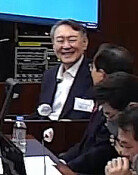Whistle Blowers Are Usually Justified
Whistle Blowers Are Usually Justified
Posted April. 04, 2006 02:59,
Mr. A, a local government worker, reported the waterworks headquarters chief of water quality research from his local government to the Korea Independent Commission Against Corruption (KICAC) recently.
The reason he reporting him was that he requested unqualified institutes to examine tap water, and then made his own researchers conduct the exams while paying the unqualified institutes for exams that they did not conduct.
A and others were fired by the local government for taking part in a strike, but were later redeemed by the KICAC.
Mr. B, a central government worker, was asked by the same office accountant to submit an estimate sheet for an office building painting job with inflated prices.
B submitted the fake estimates, and the accountant wired the inflated costs to B and received the surplus money back in cash. Afterwards, B felt guilty and reported this to the KICAC.
However, B, who had reported the case, underwent a police investigation on charges of bribery and was only released when the KICAC set the record straight.
Just as in the case of A and B, about 40 percent of corruption cases of public offices reported to the KICAC are from inside whistle blowers.
Inside whistle blowing means an act that protects the public interests and security by insiders informing the press or their supervisors about illegal, unethical, and unfair practices occurring inside an organization or group.
According to the KICACs Filed Corruption Reported 2005, which Dong-A Ilbo obtained on April 3, the number of filed cases is 91. Of these, 34 were from insiders, or 37.4 percent.
In particular, 97.1 percent, or 33 out of 34 cases, were concluded to be fair reports, and measures such as prosecution indictment were taken. In other words, inside whistle blowing reliability is almost 100 percent. In contrast, only 86 percent of reports filed by outsiders were taken by the prosecution.
In addition, external file reporting only resulted in 518 million won being seized while internal whistle blowing resulted in 3.64 billion won.
According to KICACs results on investigation-reported corruption cases, 83.3 percent of those accused by insiders were found guilty while only 57.7 percent of those charged by outsiders were found guilty. Excluding 28 civilians, the highest number of people engaged in corrupt actions and disclosed by inside whistle blowing were local government officials, amounting to 12. They were followed by six in central administration agencies and three in metropolitan governments.
Min-Hyuk Park mhpark@donga.com




![두쫀쿠가 뭐라고…영하 8도에 아이들 1시간 줄세운 어린이집 [e글e글]](https://dimg.donga.com/c/138/175/90/1/wps/NEWS/IMAGE/2026/01/09/133126969.3.jpg)
![지하철 타고 가는 북한산성…외국인도 반한 ‘K등산 맛집’[전승훈 기자의 아트로드]](https://dimg.donga.com/c/138/175/90/1/wps/NEWS/IMAGE/2026/01/10/133120824.1.jpg)

